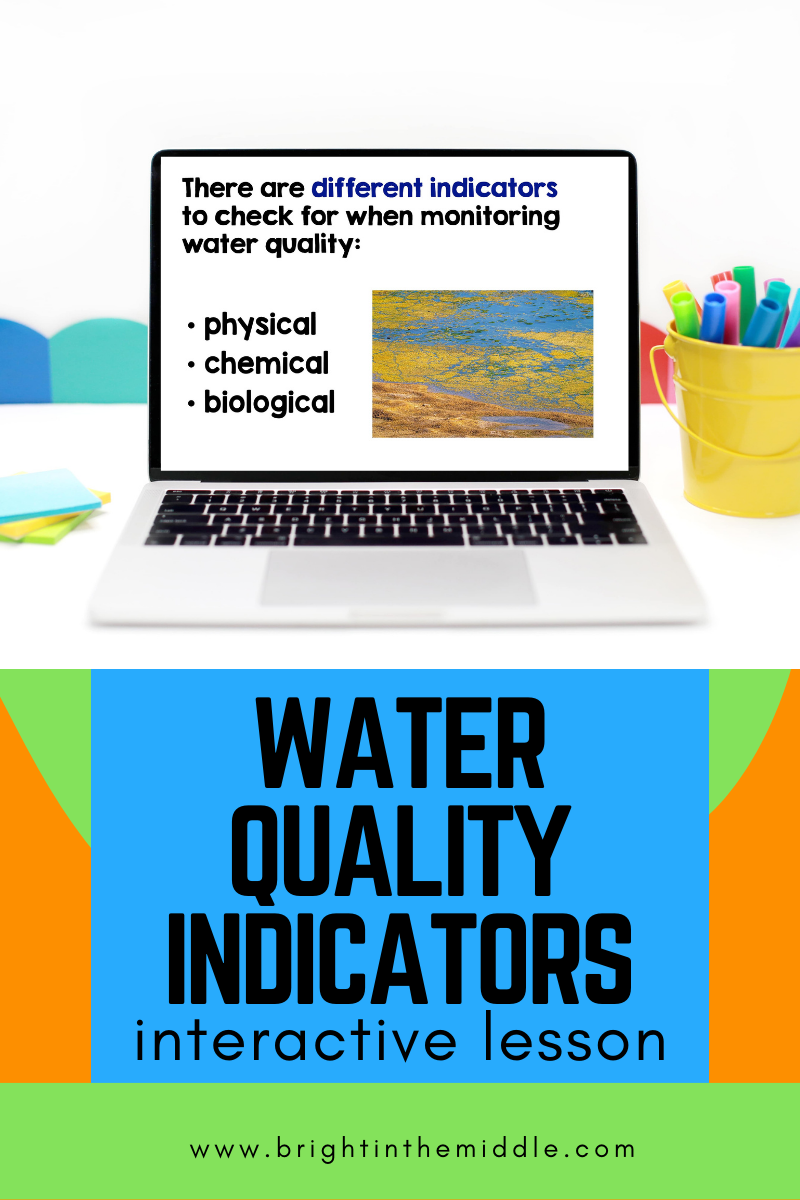Looking for some water quality activities to do for your hydrosphere unit? I got you!
Monitoring water is essential for ensuring good water quality for living things and allows for scientists and public health officials to make changes to improve if necessary. We are particularly concerned with freshwater as this is a source of potable (drinking) water and safe water (used for bathing and cleaning).
There are different things that can impact water quality such as human behaviors and seasons.
In this post, I share two WONDER strategies that you can do with your students to get them excited about learning more about water quality and why it’s important. Second, I share an interactive lesson that helps students learn about the physical, chemical, and biological water quality indicators that are checked when monitoring water quality. Finally, I share two WIDEN activities that students can do to expand their knowledge on this topic.
Which of these water quality activities will you choose?

Water Quality Activities to Help Students WONDER
Helping your students to become curious about a topic is an essential task! Once students are curious about a topic, they are internally motivated to learn, which makes your life (and theirs) so much easier! Here are two WONDER activities you can try when teaching about water quality.
Check Out Water Quality Data
Have students check out actual water quality data by USGS. They can check out different bodies of water. What makes it so neat is that you can find a local water supply and check out the indicators.
They can click the link and explore!
Here are some guiding questions you can give them.
- What bodies of water did you look at?
- What water quality indicators are being monitored?
- Why is it important to measure these things?
- How do different bodies of water compare?
- How might this data be used?
Of course, you can always add more. There are a lot of good discussions that can occur by looking at this data.
Flint, Michigan Crisis Exploration
One of the most well-known water crises is the situation in Flint, Michigan. Students may or may not have heard of it!
Here is an idea on how you can discuss this with your students and really show them how checking the quality of water sources is so very important.
- First, ask your students what they know about this situation.
- Then, show them a video summary of the crisis, like this one.
- Show them this video. I love this because it shows students checking the water quality and being passionate about this situation.
Have a discussion. Make sure they know how important it is to check water quality indicators and that you should never take clean water for granted!
Water Quality Indicators Interactive Lesson
Now that students are aware of how important checking the water quality is, they will be more excited to take a deep dive into what specific things need to be checked!
Interactive lessons will help students retain the material, and they are fun! They are designed with the 7 steps to helps students retain information in mind!

In this water quality indicators interactive lesson, students will learn about the purpose for testing water quality, why water quality is important, and they will learn about the indicators temperature, turbidity, dissolved oxygen, pH, nitrates and phosphates, salinity, and macroinvertebrates. They will also learn about eutrophication, the dead zone, indicator organisms, and more!
The lesson is designed with interactive activities to help students process information. These include an anticipation guide, drag-and-drop activities, text box questions, four corners vocabulary, and more!
You can find this in the Bright in the Middle Shop.
You can also find this on TPT.
Water Quality Activities for Students to WIDEN Knowledge
There is always so much to explore to expand student knowledge! Here are two ideas that you can try with your students. It’s hard to choose just one!
Build a Water Filter
What if you were in a situation where you did not have access to clean water? What would you do?
For a great STEM activity, students can create their own water filter using everyday materials.
Gather materials such as coffee filters, rocks, clean sand, paper towels, soda/water bottles, cotton balls, rubber bands, cups, etc.
Have students design and tests their water filters.
Here are some helpful videos to explore more.
How to Filter Water DIY Science
How to Make a Simple Water Filter
Test Local Water Quality
Have time for a local investigation? Whether you take a field trip or bring in water samples, there are many different ways you can do this.
Check out this helpful resource!
Help your students master science content!



[…] Water Quality Indicators […]